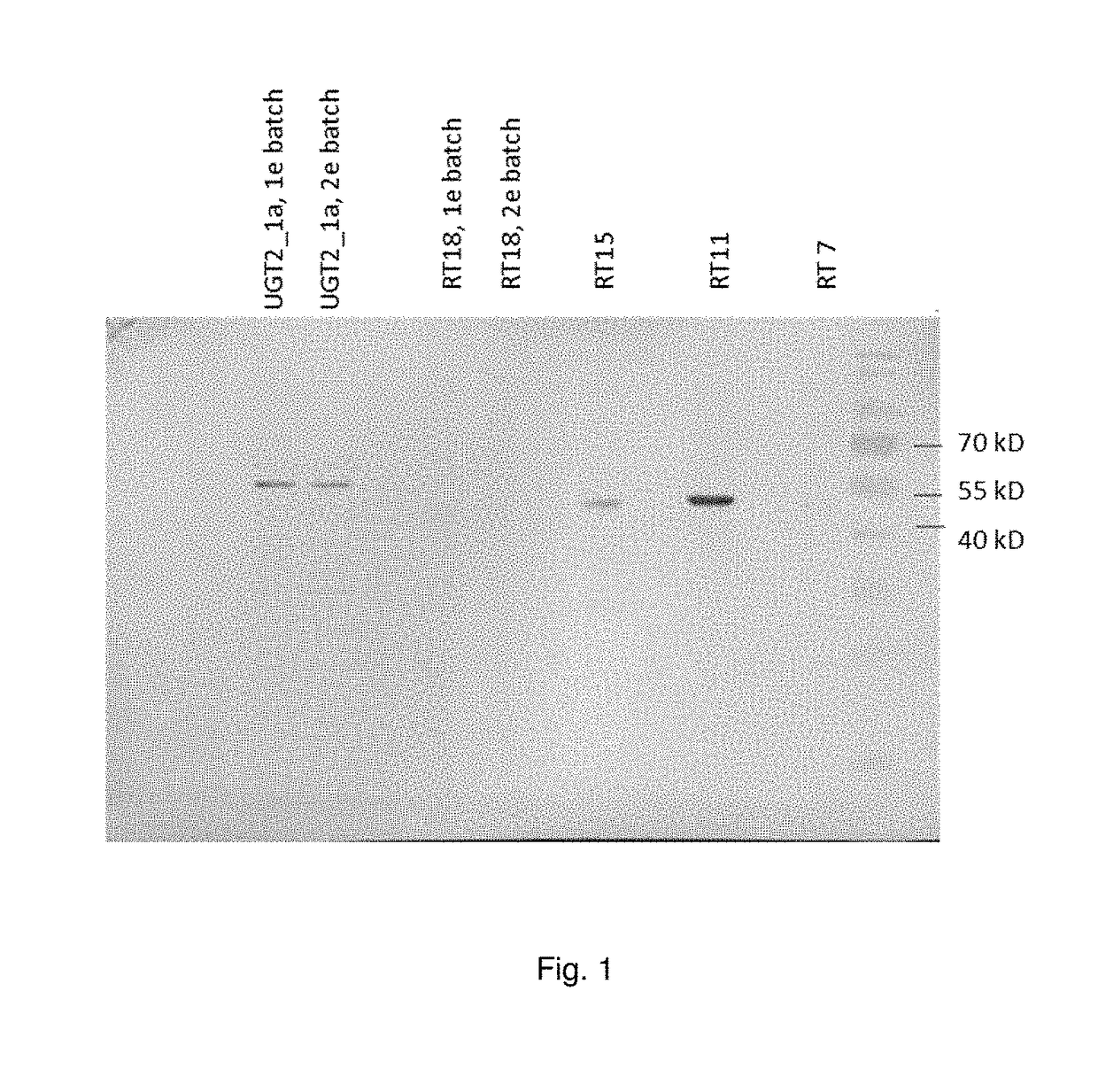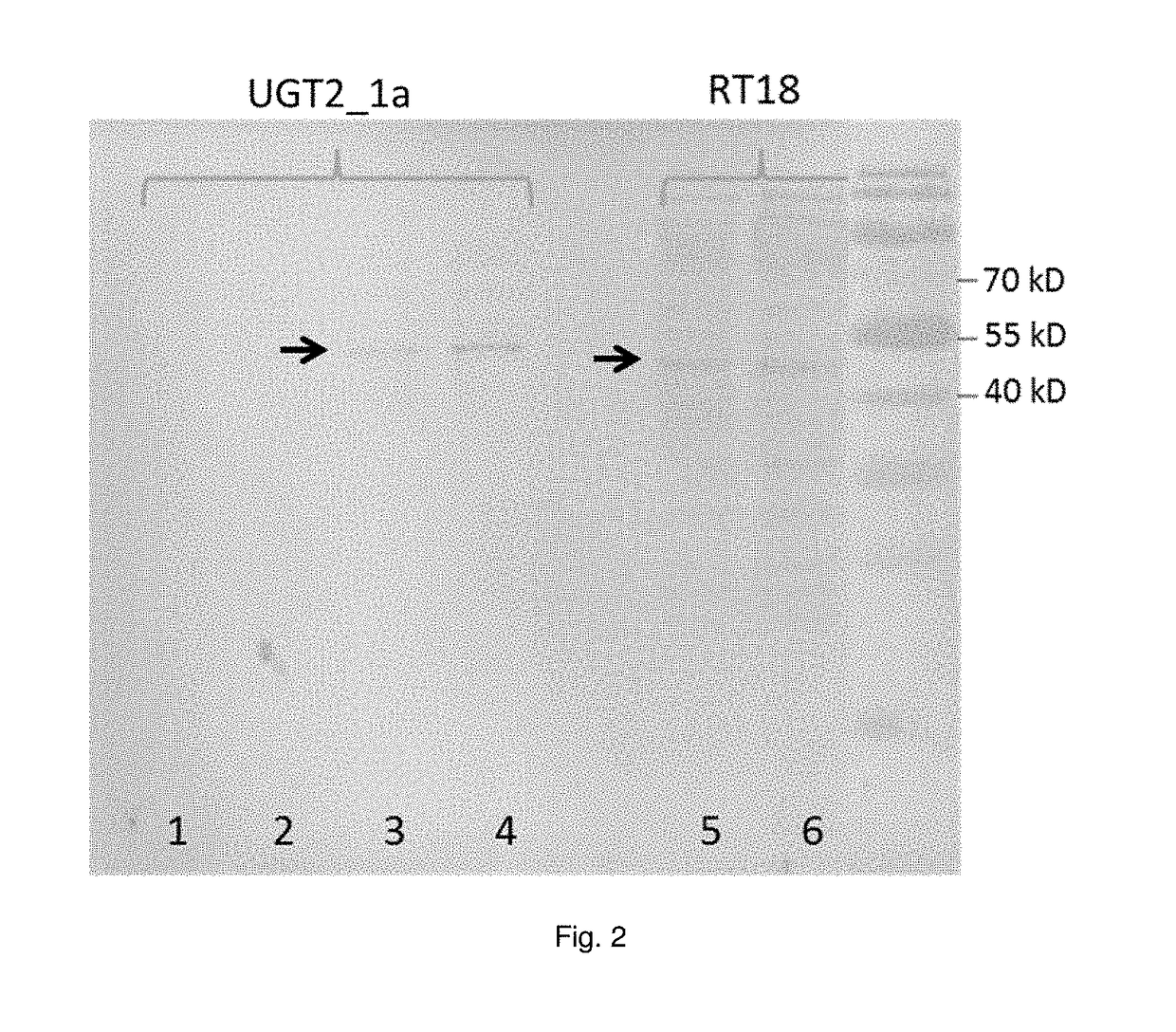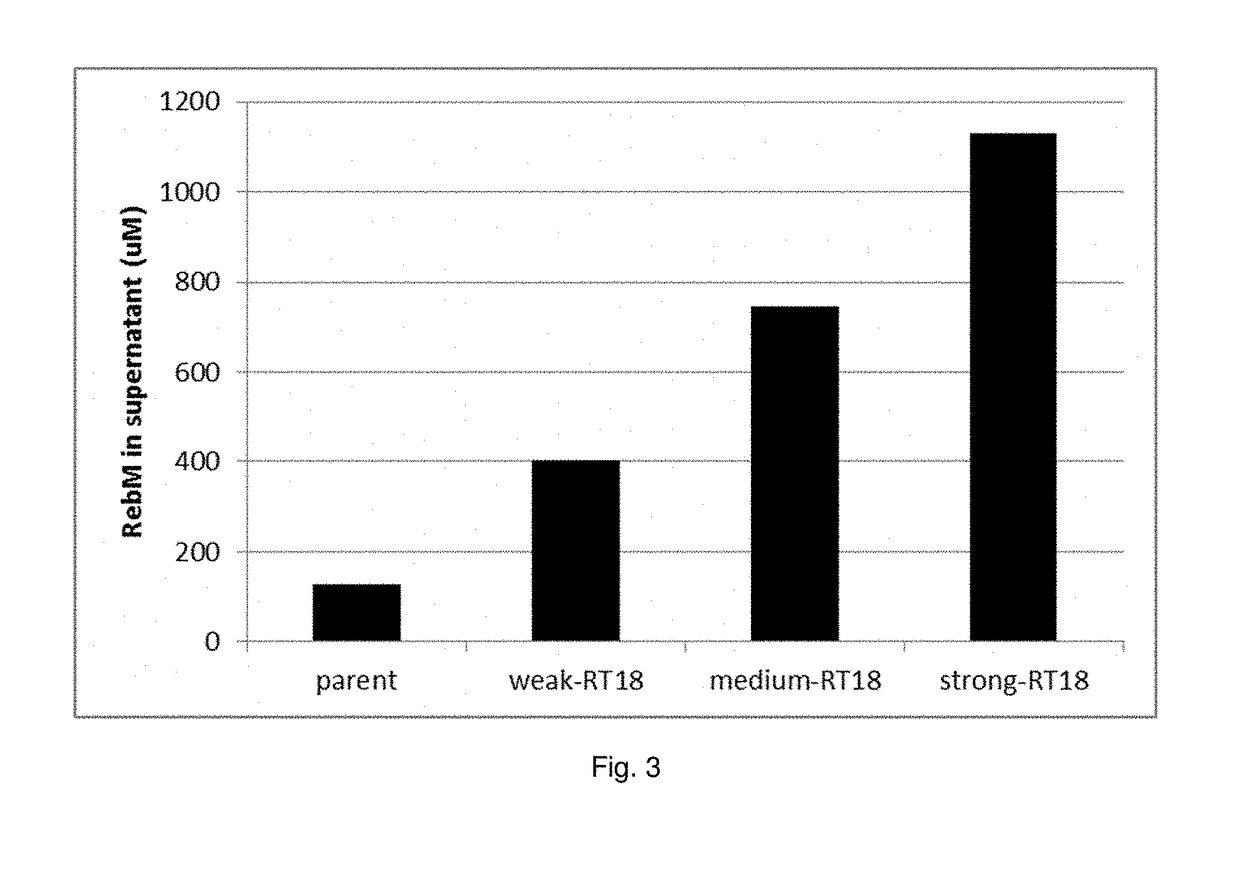Udp-glycosyltransferases from solanum lycopersicum
a technology of glycosyltransferases and solanum lycopersicum, which is applied in the field of recombinant hosts, can solve the problems of large land area, variable yield, and increased labor costs, and achieves the effect of reducing labor costs and increasing yields
- Summary
- Abstract
- Description
- Claims
- Application Information
AI Technical Summary
Benefits of technology
Problems solved by technology
Method used
Image
Examples
example 1
Construction of E. coli Expression Vectors
[0216]The full length open reading frame encoding UGTs from Solanum lycopersicon were amplified from S. lycopersicon cDNA. 1 μg of total RNA isolated from tomato fruit was used as starting material to prepare cDNA using the SMART™ RACE cDNA Amplification Kit (Clontech), according to the manufacturer's instructions.
[0217]For amplification Phusion “proofreading polymerase” (Finnzymes) and the primers mentioned in Table 1 were used.
TABLE 1primers used to amplify tomato and stevia UGT fraqmentsForward primerReverse primerRT7ATTAGGATCCAATGGGAACACAAGTAACAGAGAATACTGCAGTTAATTAGTACTAATCTTACAAAATTGRh11ATTAGGATCCAATGGAAGCCAAGAAAAATAAAATGAGAATACTGCAGTCATTTGTTGCTGCAAAGAGCCATCRh15ATTAGGATCCAATGGATGGTTCGAATGAAAAGTCAATACTGCAGCTAGACAACATTTGATCTAGTCTTGRh18ATTAGGATCCAATGAGTACTACTTTAAAGGTATTGATAATACTGCAGATTCACTTATTACTATTCCTACAAAGGUGT2_1aATTAGGATCCAATGGCCACTTCTGACTCCATAATAAAGCTTTTAGCTTTCGTGGTCAATGGCA85C2ATTAGGATCCAATGGACGCTATGGCCACCACTAATAAAGCTTTTAGTTTCGAGCCAAGA...
example 2
Synthesis of Steviolmonoside by UGT85C2
[0220]To prepare Steviolmonoside enzymatically from Steviol (Sigma U4625) and UDP-glucose (Sigma 4625), the following compounds were mixed in a total reaction volume of 4 ml. For preparation of a crude enzyme extract of UGT85C2 see Example 3.
μl100 mM 2-mercaptoethanol in 0.1M Tris-buffer160100 mM UDP-glucose in 10% DMSO800100 mM Steviol in 100% DMSO40Crude enzyme extract UGT85C2400
[0221]The glycosylation reaction was performed overnight at 30° C. and 100 rpm. Subsequently the reaction was purified using an Oasis hydrophiliclipophilic-Balanced (HLB) 3 cc extraction cartridge (Waters), which had been preconditioned according to the manufacturer's instructions. The enzymatic reaction was loaded on the HLB column, and allowed to enter the column by gravity flow. Subsequently the column was washed with 6 mL of water. Product was eluted by passing 3 ml of 100% methanol over the column. The methanol elute was dried under vacuum centrifugation and the ...
example 3
In Vitro Comparison of Different Tomato UGTs and Stevia UGT2 1a
[0222]The control plasmid pACYC-DUET-1 and the UGT constructs were transformed to E. coli BL21 DE3 (Invitrogen). For expression, a 3 mL overnight culture of the recombinant E. coli strains was prepared (LB medium with appropriate antibiotic; 50 μg chloramphenicol / mL and 1% glucose). 200 μL of that culture was transferred to 20 mL of LB medium with the appropriate antibiotic in a 100 mL Erlenmeijer flask, and incubated at 37° C., 250 rpm until the A600 was 0.4 to 0.6. Subsequently IPTG was added to a final concentration of 1 mM and cultures were incubated overnight at 18° C. and 250 rpm. The next day, cells were harvested by centrifugation (10 min 8000×g), medium was removed, and cells were resuspended in 1 mL Resuspension buffer (100 mM Tris-HCl pH=7.5, 1.4 mM 2-mercaptoethanol; 4° C., 15% glycerol). Cells were disrupted by two times shaking with 200 mg 0.1 mm Zirconia / Silica Beads (BioSpec) for 10 seconds in a FastPrep ...
PUM
| Property | Measurement | Unit |
|---|---|---|
| Fraction | aaaaa | aaaaa |
| Volume | aaaaa | aaaaa |
| Volume | aaaaa | aaaaa |
Abstract
Description
Claims
Application Information
 Login to View More
Login to View More - R&D
- Intellectual Property
- Life Sciences
- Materials
- Tech Scout
- Unparalleled Data Quality
- Higher Quality Content
- 60% Fewer Hallucinations
Browse by: Latest US Patents, China's latest patents, Technical Efficacy Thesaurus, Application Domain, Technology Topic, Popular Technical Reports.
© 2025 PatSnap. All rights reserved.Legal|Privacy policy|Modern Slavery Act Transparency Statement|Sitemap|About US| Contact US: help@patsnap.com



